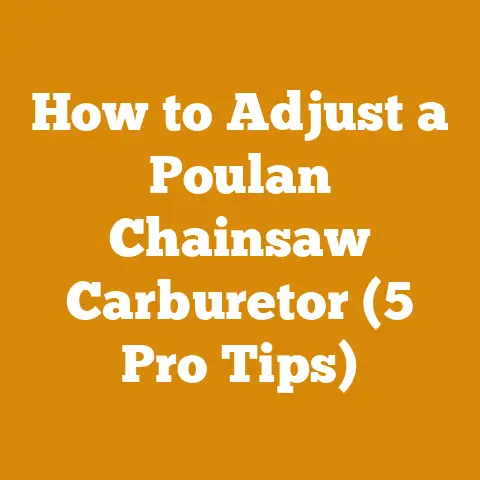Poplar Tree Suckers (5 Pro Tips) for Efficient Wood Processing
Innovation in wood processing never sleeps.
From advancements in chainsaw technology to more efficient splitting techniques, there’s always something new to learn and implement.
One challenge that consistently pops up, especially for those of us working with poplar trees, is dealing with the relentless growth of suckers.
These pesky shoots can quickly turn a manageable woodlot into an overgrown thicket, impacting both the health of the trees and the efficiency of wood processing.
Over the years, I’ve developed some pro tips to manage poplar suckers effectively, ensuring smoother wood processing and healthier trees.
Understanding Poplar Suckers
Before diving into the “how,” let’s understand the “why.” Poplar trees, known for their rapid growth, have an extensive root system.
These roots are prone to sending up suckers—new shoots that emerge from the roots, often far from the main trunk.
This is a natural propagation method for the tree, but in a managed environment, it can be a real nuisance.
Think of it this way: you’ve carefully thinned your poplar stand, envisioning a productive source of firewood or lumber.
Then, seemingly overnight, a swarm of suckers appears, competing with the remaining trees for resources like sunlight, water, and nutrients.
This not only hinders the growth of your desired trees but also creates a dense understory that’s difficult to navigate and process.
From my experience, the key to effective sucker control is a combination of understanding the tree’s biology and applying the right techniques at the right time.
Pro Tip 1: Timing is Everything
The timing of your sucker control efforts can significantly impact their effectiveness.
The best time to tackle poplar suckers is during the growing season, specifically in late spring or early summer.
This is when the suckers are actively growing and more susceptible to control measures.
Why this timing works:
- Active Growth: During the growing season, the suckers are actively transporting nutrients from the leaves to the roots.
This means that any herbicide applied will be more readily absorbed and translocated throughout the plant, increasing its effectiveness. - Visible Targets: The suckers are more visible and easier to target, reducing the risk of damaging desirable plants.
- Reduced Seed Production: Controlling suckers before they mature prevents them from producing seeds, further reducing their spread.
I remember one year, I waited too long to address the suckers in my poplar stand.
By late summer, they were already quite established, and my control efforts were much less effective.
Since then, I’ve made it a point to scout for suckers regularly in the spring and take action as soon as they appear.
Actionable Steps:
- Mark Your Calendar: Set reminders in late spring to check for poplar suckers.
- Regular Scouting: Walk through your poplar stand or woodlot at least once a week during the growing season.
- Early Intervention: Take action as soon as you spot new suckers.
Pro Tip 2: Manual Removal Techniques
For smaller infestations or in areas where you want to avoid using herbicides, manual removal is a viable option.
This involves physically removing the suckers by cutting or pulling them out of the ground.
While it can be labor-intensive, manual removal is an effective and environmentally friendly way to control poplar suckers.
Tools You’ll Need:
- Pruning Shears: For cutting smaller suckers.
- Loppers: For thicker suckers.
- Shovel: For digging out suckers with extensive root systems.
- Gloves: To protect your hands from thorns and irritants.
How to Do It:
- Cut or Pull: For small suckers, you can simply cut them off at ground level using pruning shears or loppers.
For larger suckers, try pulling them out of the ground, making sure to remove as much of the root system as possible. - Dig It Out: If the suckers have a deep or extensive root system, use a shovel to dig them out.
This is especially important for larger suckers that have been growing for a while. - Repeat as Needed: Manual removal is an ongoing process.
You’ll need to regularly check for new suckers and remove them as they appear.
My Experience:
I’ve found that manual removal is most effective when the soil is moist, making it easier to pull out the suckers.
After a good rain, I often spend an afternoon walking through my poplar stand, pulling out any new suckers that have emerged.
It’s a bit of a workout, but it’s a satisfying way to keep the suckers under control.
Important Considerations:
- Persistence is Key: Manual removal requires consistent effort.
Don’t expect to eliminate all the suckers with a single pass. - Root Removal: Removing as much of the root system as possible is crucial to prevent regrowth.
- Soil Disturbance: Be mindful of soil disturbance, as it can stimulate new sucker growth.
Pro Tip 3: Herbicide Application
When manual removal isn’t practical or effective enough, herbicides can be a valuable tool for controlling poplar suckers.
However, it’s essential to use herbicides responsibly and according to the manufacturer’s instructions.
Choosing the Right Herbicide:
- Glyphosate: A non-selective herbicide that kills most plants it comes into contact with.
It’s effective for controlling suckers but should be used with caution to avoid damaging desirable trees. - Triclopyr: A selective herbicide that targets woody plants, making it a good choice for controlling suckers without harming grasses.
- Imazapyr: A systemic herbicide that is absorbed by the plant and translocated throughout the root system.
It’s highly effective for controlling suckers but can also affect nearby trees if not used carefully.
Application Methods:
- Foliar Spray: Applying the herbicide directly to the leaves of the suckers.
This is most effective when the suckers are actively growing. - Cut-Stump Treatment: Cutting the sucker at ground level and applying the herbicide to the freshly cut stump.
This method is effective for preventing regrowth. - Basal Bark Treatment: Applying the herbicide to the bark of the sucker, near the base of the tree.
This method is effective for controlling larger suckers.
Safety Precautions:
- Read the Label: Always read and follow the manufacturer’s instructions for the herbicide you are using.
- Wear Protective Gear: Wear gloves, eye protection, and a respirator when applying herbicides.
- Avoid Drift: Be careful to avoid drift, which can damage desirable plants.
- Weather Conditions: Apply herbicides on a calm day, when there is no wind.
- Water Sources: Avoid applying herbicides near water sources.
My Experience:
I’ve used glyphosate for foliar spraying on small suckers, being very careful to shield the surrounding trees.
For larger suckers, I’ve found the cut-stump treatment with triclopyr to be quite effective.
The key is to apply the herbicide immediately after cutting the sucker, ensuring that it’s absorbed into the root system.
Important Considerations:
- Herbicide Resistance: Overuse of herbicides can lead to resistance.
Rotate between different herbicides to prevent this. - Environmental Impact: Be mindful of the environmental impact of herbicides.
Use them sparingly and only when necessary. - Local Regulations: Check your local regulations regarding herbicide use.
Pro Tip 4: Cultural Practices to Minimize Sucker Growth
Beyond direct control methods, implementing certain cultural practices can help minimize sucker growth in the first place.
These practices focus on promoting the health and vigor of the main trees, which in turn reduces the tree’s tendency to send up suckers.
Key Cultural Practices:
- Proper Watering: Ensure that your poplar trees receive adequate water, especially during dry periods.
Water stress can trigger sucker growth. - Fertilization: Fertilize your poplar trees regularly to provide them with the nutrients they need to thrive.
A balanced fertilizer with nitrogen, phosphorus, and potassium is ideal. - Mulching: Apply a layer of mulch around the base of your poplar trees to help retain moisture, suppress weeds, and regulate soil temperature.
- Pruning: Prune your poplar trees regularly to remove dead, damaged, or diseased branches.
This helps improve air circulation and sunlight penetration, promoting overall tree health. - Avoid Soil Disturbance: Minimize soil disturbance around the base of your poplar trees, as this can stimulate sucker growth.
Why These Practices Work:
- Healthy Trees: Healthy trees are less likely to send up suckers as a survival mechanism.
- Reduced Stress: Proper watering, fertilization, and mulching reduce stress on the trees, making them less prone to sucker growth.
- Improved Sunlight: Pruning improves sunlight penetration, which can help suppress sucker growth.
My Experience:
I’ve noticed a significant reduction in sucker growth in my poplar stand since I started implementing these cultural practices.
I make sure to water my trees regularly during dry periods, fertilize them in the spring, and apply a thick layer of mulch around the base of each tree.
I also prune them annually to remove any dead or damaged branches.
Actionable Steps:
- Watering Schedule: Establish a regular watering schedule for your poplar trees, especially during dry periods.
- Fertilization Plan: Develop a fertilization plan based on the needs of your trees and the soil conditions.
- Mulch Application: Apply a 2-4 inch layer of mulch around the base of your poplar trees, keeping it away from the trunk.
- Pruning Schedule: Prune your poplar trees annually to remove dead, damaged, or diseased branches.
- Soil Testing: Conduct soil tests to determine the nutrient levels in your soil and adjust your fertilization plan accordingly.
Pro Tip 5: Utilizing Suckers for Propagation (If Desired)
While suckers are often considered a nuisance, they can also be a valuable resource for propagating new poplar trees.
If you’re interested in expanding your poplar stand or creating new plantings, you can utilize the suckers to your advantage.
How to Propagate Poplar Trees from Suckers:
- Select Healthy Suckers: Choose healthy, vigorous suckers that are at least 1-2 feet tall.
- Dig Them Up: Carefully dig up the suckers, making sure to retain as much of the root system as possible.
- Prepare the Planting Site: Choose a suitable planting site with well-drained soil and plenty of sunlight.
- Plant the Suckers: Plant the suckers at the same depth they were growing previously, spacing them appropriately.
- Water and Care: Water the newly planted suckers regularly and provide them with the same care you would give to any other young tree.
My Experience:
I’ve successfully propagated several poplar trees from suckers using this method.
It’s a great way to expand your poplar stand without having to purchase new trees.
I usually dig up the suckers in the spring and plant them in a nursery bed, where they can grow for a year or two before being transplanted to their permanent location.
Important Considerations:
- Genetic Consistency: Trees propagated from suckers will be genetically identical to the parent tree.
This can be an advantage if you’re trying to maintain a specific variety of poplar. - Root Development: Suckers may not have as well-developed root systems as trees grown from seed or cuttings.
Provide them with extra care during the first few years to ensure they establish properly. - Disease Transmission: Be aware that suckers can transmit diseases from the parent tree.
Choose suckers from healthy trees to minimize this risk.
The Bigger Picture: Sustainable Wood Processing
Managing poplar suckers effectively is not just about aesthetics or convenience; it’s an integral part of sustainable wood processing.
By controlling sucker growth, I ensure that my poplar trees have the resources they need to grow strong and healthy, ultimately leading to a more productive and sustainable woodlot.
Benefits of Sustainable Wood Processing:
- Increased Productivity: Healthy trees produce more wood, leading to increased productivity.
- Improved Wood Quality: Trees that are not competing with suckers for resources produce higher-quality wood.
- Reduced Environmental Impact: Sustainable wood processing practices minimize environmental impact and promote biodiversity.
- Long-Term Viability: Sustainable practices ensure the long-term viability of your woodlot.
Final Thoughts:
Dealing with poplar suckers can be a challenge, but by implementing these pro tips, I’ve been able to effectively manage sucker growth and maintain a healthy, productive poplar stand.
Remember, timing is everything, manual removal is a viable option, herbicides should be used responsibly, cultural practices can minimize sucker growth, and suckers can even be utilized for propagation.
By adopting a holistic approach to sucker management, you can ensure the long-term health and productivity of your poplar trees and contribute to sustainable wood processing.
The journey of wood processing is one of continuous learning and adaptation.
Each challenge, like the persistent growth of poplar suckers, presents an opportunity to refine our techniques and deepen our understanding of the natural world.
So, grab your pruning shears, put on your gloves, and get ready to tackle those suckers!
Your efforts will be rewarded with a healthier, more productive woodlot and the satisfaction of knowing that you’re contributing to a more sustainable future.






